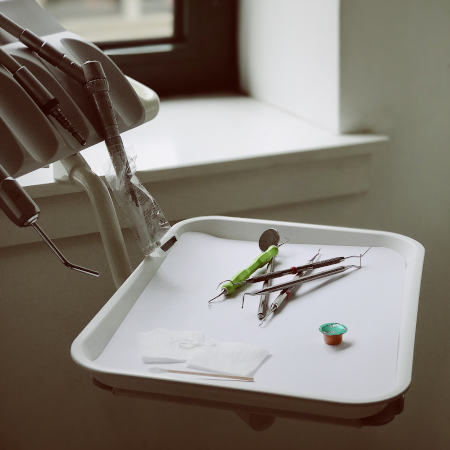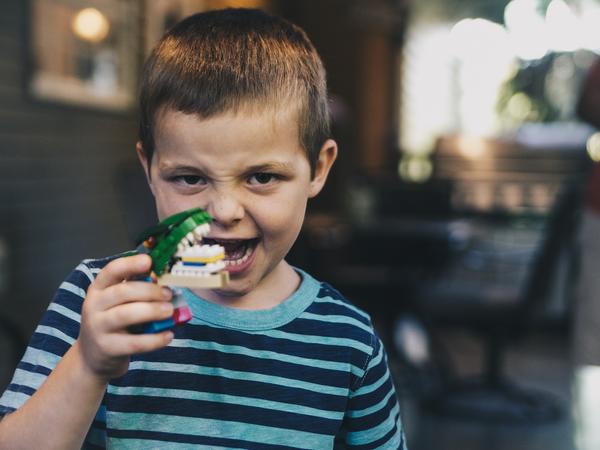Breastfeeding and dental health - Will my child get cavities from breastfeeding?
I recently had my first dentist appointment with my 15-month-old daughter. She just got her first two teeth. Before the appointment, I was sent a detailed medical history sheet, which was discussed at the appointment.

The dental assistant and also the dentist both faltered that we were still breastfeeding quite a bit at night. They told me that my daughter would soon get cavities from this and recommended that I wean soon.

Since I had already encountered similar comments from the dentist's office in my consultations and in reports from friends, I decided to take a closer look at this aspect. To do this, I looked at both professional articles and studies.
Table of contents
How does caries develop?
How does caries develop in the first place? I would like to start by answering this question. In this context, I would also like to describe what teeth are actually made of, because this knowledge is just as important.
The following infographic shows the basic structure of a tooth.

Teeth are incredibly hard and normally resistant. Demineralization, i.e. (partial destruction) of the enamel, is not possible in the normal oral environment. It is when the PH in the mouth becomes more acidic that this decomposition occurs, and only then can minerals be released from the enamel.
Caries is mainly caused by the pathogen Streptococcus mutans. These bacteria are naturally found in dental plaque and produce acids during metabolism that attack the enamel, making the oral environment more acidic and thus promoting the development of caries. In the early stages, a chalky white or brownish stain appears on the affected tooth, as I read in the article How dental caries develops from www.kindergesundheit-info.de.
Streptococcus mutans, the "caries pathogen" requires short-chain carbohydrates for metabolism. Basically, carbohydrates are divided into different categories: single, double and multiple sugars (mono-, di-, oligosaccharides). For caries bacteria, only the rapidly soluble sugars are significant, i.e. primarily the monosaccharides and disaccharides. These include, for example, fructose and lactose. You can read more about this in the article Breast milk and dental health from www.afs-stillen.de.
Tooth decay occurs when the degradation of the tooth enamel is greater than the new formation or regeneration, which is favored by saliva.
Furthermore, I can read there that minimal damage can also regenerate if there is no renewed contact with the pathogen. The calcium and phosphate content of saliva has a regenerating and caries-inhibiting effect. It is important for this that there is sufficient time between meals.
You can find more information on the development of caries in general in the article How does caries develop? from www.kzbv.de (Kassenzahnärztliche Bundesvereinigung).
Basically, the development of caries is also related to personal predisposition. In addition, caries can also be "transmitted", caries has been classified as an infectious disease for some time. If parents have pronounced caries, contagion to the baby or young child can occur. It is therefore not insignificant that you as mom and dad also take appropriate care of your teeth, because caries pathogens can be passed on through saliva contact. However, with a healthy oral flora on the part of parents, it is not necessary to avoid all saliva contact.
Video explanation of the development of caries
The Youtube channel The Simple Biology has explained the development of caries a little more precisely than I did in the following video.
So far so good, but what does this have to do with breastfeeding? And how is it, if there is just not "sufficient distance between the meals"?
Breast milk and caries
Now it can be assumed that breast milk, just like other food or even bottled milk, would promote the development of caries. After all, it also contains lactose, which is metabolized by the caries pathogens and thus forms acid, which can then attack the tooth enamel.
But it is not that easy. Let's take a closer look.
Compared to the breast, a bottle lies much further forward in the mouth, so the milk automatically comes into contact with the teeth. A breastfeeding child, on the other hand, has the breast deep in the mouth near the palate, so the milk is much further back in the mouth when he or she sucks.
It also helps to look at the ingredients in breast milk. Among many other ingredients, breast milk contains not only various lactose, but also various immunoglobulins, which can directly render bacteria harmless.

At the same time, breast milk also contains various minerals, such as calcium and phosphate, which support the remineralization of teeth.
You can learn more about the ingredients of breast milk in my article The wonderful composition of breast milk.
Overall, there are a lot of studies in this regard and various criteria must be taken into account when paying attention to these studies. Among other things, you have to look at how the methodology of the study was and who financed it. These and other factors obviously affect the results and must be taken into account.
Overall, breastfeeding appears to have a positive impact on dental health rather than a negative impact. (Prolonged) breastfeeding also has a positive effect with regard to dental malocclusions.

At the end of the article you will find a list of sources and links to studies and articles for further reading.
Not to mention, the WHO recommendation regarding breastfeeding duration is that babies should be exclusively breastfed for six months, and then until they are two years old and beyond, as long as both mother and child want it.
Now, some babies get their teeth very early, and in very rare exceptions, babies are even born with teeth. How could this have happened earlier without formula milk? After all, the first teeth are not called"milk teeth" for nothing. The natural weaning age is also between two and seven years, depending on the source and various factors.
However, there is no question that there are certain risk factors for the development of caries and that teeth should be cared for. This is exactly what I would like to discuss below.
Get fit for your breastfeeding start in my online course
Learn many important basics about breastfeeding in my online course Still Basics.
Reducing the risk of tooth decay and proper dental care
But if it's not breastfeeding that causes my child to develop tooth decay, what can I do to prevent it? What causes tooth decay?
The German Federal Center for Health Education describes that fluorides are of great importance for dental health. In addition to fluoride tablets for babies, it is therefore recommended to brush the tooth or teeth once a day with a fluoride toothpaste from the first tooth onwards. In this context, it is important to note that babies and toddlers still need significantly less toothpaste. From the complete milk dentition or from the second birthday, brushing twice a day with toothpaste is recommended.
The German Society for Dental, Oral and Maxillofacial Medicine (DGZMK), on the other hand, has a different opinion and is against systemic fluoride treatment; consequently, the tablets could be omitted in this case.
Here, too, it is clear that there are different opinions with regard to dental care.
After eating, the teeth should be rinsed with water. For this, it is enough if your baby or toddler drinks some water to remove at least coarse food debris.

Sugary drinks should be avoided, especially between meals, but also in general. Sugary foods are just as much a risk for tooth decay. It is important to note that milk sugar, fruit sugar and glucose are also a risk here. Sometimes, therefore, it helps to look at the ingredients of drinks and foods.
At the same time, regular visits to the dentist are important, starting with the first milk tooth. Here you can also ask any questions you may have about dental care and get tips on dental care. If you are unsure about any information, feel free to question it.
Sources and literature for further reading
- AFS article on breast milk and dental health: www.afs-stillen.de/fachinfos/muttermilch-und-zahngesundheit
- Article in the breastfeeding encyclopedia about breastfeeding and tooth decay: www.still-lexikon.de/stillen-und-karies
- Article on the recommendations on breastfeeding, pacifiers and co in relation to dental health by the North Rhine Dental Association: www.zahnaerztekammernordrhein.de/fuer-patienten-beratung-service/stillen-schnuller-und-co
- Article by the European Institute for Breastfeeding and Lactation on the subject of breastfeeding and dental health: www.stillen-institut.com/de/zahngesundheit.html (here you will also find further references to studies)
- Article on the connection between breastfeeding and caries by Dr. Gumpert: www.dr-gumpert.de/html/karies_durch_stillen.html
- Article by the German Federal Center for Health Education on dental care recommendations: www.kindergesundheit-info.de/themen/risiken-vorbeugen/zahngesundheit/gesunde-zaehne
The cover image is a photo by Christian Hermann and comes from unsplash.com.
The photo of the sleeping baby is by Peter Oslanec and comes from unsplash.com.
The photo of the child with toy teeth is by Eddie Kopp and comes from unsplash .com.
The photo of the laughing child at the table is by kazuend and comes from unsplash.com.
The photo of the breastfeeding mother is by Luiza Braun and comes from unsplash.com.
The photo of the dentist's cutlery is by Jon Tyson and comes from unsplash.com.
No comments yet.